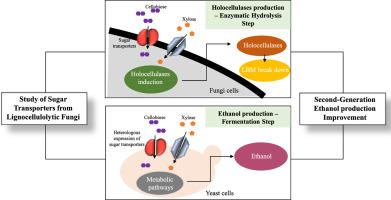Renewable and Sustainable Energy Reviews ( IF 16.3 ) Pub Date : 2020-06-29 , DOI: 10.1016/j.rser.2020.109991 Karoline Maria Vieira Nogueira , Vanessa Mendes , Cláudia Batista Carraro , Iasmin Cartaxo Taveira , Letícia Harumi Oshiquiri , Vijai K. Gupta , Roberto N. Silva

|
Second-generation ethanol (2G ethanol) has emerged as a promising alternative to fossil fuels owing to the usage of lignocellulosic biomass (LCB) as feedstock. LCB is mainly composed of cellulose, hemicellulose, and lignin. Biochemical conversion of LCB into ethanol involves four significant steps including pre-treatment, enzymatic hydrolysis, fermentation, and distillation. The major bottleneck to economically feasible 2G ethanol production lies in saccharification and fermentation steps. Lignocellulolytic fungi represent the major commercial sources of biomass-degrading carbohydrate-active enzymes (CAZymes) and possessa complex transporter system that is capable of effectively transporting thesugars released from holocellulosehydrolysates. In this context, an improved understanding of fungal sugar transporters can represent an important strategy to overcome the above-mentioned limitations. With this backdrop, the current paper reviews thesugar transporters from lignocellulolytic fungi, and their importance in 2G ethanol production.
中文翻译:

工业真菌的糖转运蛋白:提高第二代乙醇产量的关键
由于使用木质纤维素生物质(LCB)作为原料,第二代乙醇(2G乙醇)已成为有前途的矿物燃料替代品。LCB主要由纤维素,半纤维素和木质素组成。LCB的生物化学转化为乙醇涉及四个重要步骤,包括预处理,酶水解,发酵和蒸馏。经济上可行的2G乙醇生产的主要瓶颈在于糖化和发酵步骤。木质纤维素分解真菌代表了降解生物质的碳水化合物活性酶(CAZymes)的主要商业来源,并拥有能够有效运输从全纤维素水解产物中释放的糖的复杂转运系统。在这种情况下,对真菌糖转运蛋白的更好理解可以代表克服上述局限性的重要策略。在此背景下,本论文综述了木质纤维素分解真菌的糖转运蛋白及其在2G乙醇生产中的重要性。











































 京公网安备 11010802027423号
京公网安备 11010802027423号